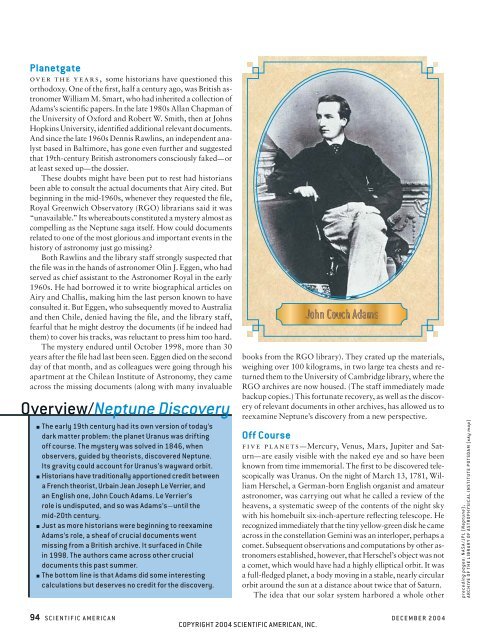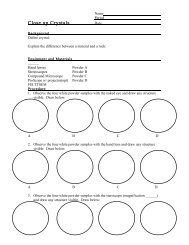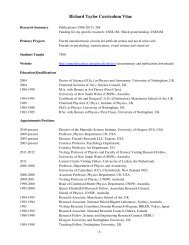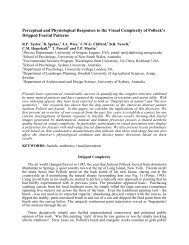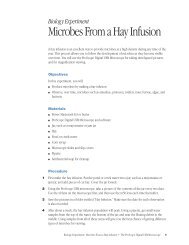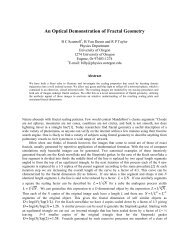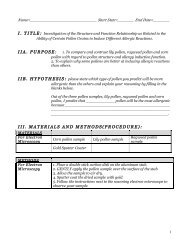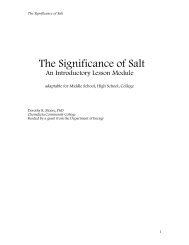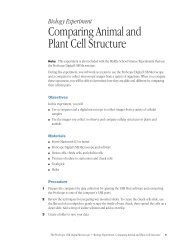December 2004 - Materials Science Institute - University of Oregon
December 2004 - Materials Science Institute - University of Oregon
December 2004 - Materials Science Institute - University of Oregon
You also want an ePaper? Increase the reach of your titles
YUMPU automatically turns print PDFs into web optimized ePapers that Google loves.
Planetgate<br />
over the years, some historians have questioned this<br />
orthodoxy. One <strong>of</strong> the fi rst, half a century ago, was British astronomer<br />
William M. Smart, who had inherited a collection <strong>of</strong><br />
Adams’s scientifi c papers. In the late 1980s Allan Chapman <strong>of</strong><br />
the <strong>University</strong> <strong>of</strong> Oxford and Robert W. Smith, then at Johns<br />
Hopkins <strong>University</strong>, identifi ed additional relevant documents.<br />
And since the late 1960s Dennis Rawlins, an independent analyst<br />
based in Baltimore, has gone even further and suggested<br />
that 19th-century British astronomers consciously faked—or<br />
at least sexed up—the dossier.<br />
These doubts might have been put to rest had historians<br />
been able to consult the actual documents that Airy cited. But<br />
beginning in the mid-1960s, whenever they requested the fi le,<br />
Royal Greenwich Observatory (RGO) librarians said it was<br />
“unavailable.” Its whereabouts constituted a mystery almost as<br />
compelling as the Neptune saga itself. How could documents<br />
related to one <strong>of</strong> the most glorious and important events in the<br />
history <strong>of</strong> astronomy just go missing?<br />
Both Rawlins and the library staff strongly suspected that<br />
the fi le was in the hands <strong>of</strong> astronomer Olin J. Eggen, who had<br />
served as chief assistant to the Astronomer Royal in the early<br />
1960s. He had borrowed it to write biographical articles on<br />
Airy and Challis, making him the last person known to have<br />
consulted it. But Eggen, who subsequently moved to Australia<br />
and then Chile, denied having the fi le, and the library staff,<br />
fearful that he might destroy the documents (if he indeed had<br />
them) to cover his tracks, was reluctant to press him too hard.<br />
The mystery endured until October 1998, more than 30<br />
years after the fi le had last been seen. Eggen died on the second<br />
day <strong>of</strong> that month, and as colleagues were going through his<br />
apartment at the Chilean <strong>Institute</strong> <strong>of</strong> Astronomy, they came<br />
across the missing documents (along with many invaluable<br />
Overview/Neptune Discovery<br />
■ The early 19th century had its own version <strong>of</strong> today’s<br />
dark matter problem: the planet Uranus was drifting<br />
<strong>of</strong>f course. The mystery was solved in 1846, when<br />
observers, guided by theorists, discovered Neptune.<br />
Its gravity could account for Uranus’s wayward orbit.<br />
■ Historians have traditionally apportioned credit between<br />
a French theorist, Urbain Jean Joseph Le Verrier, and<br />
an English one, John Couch Adams. Le Verrier’s<br />
role is undisputed, and so was Adams’s—until the<br />
mid-20th century.<br />
■ Just as more historians were beginning to reexamine<br />
Adams’s role, a sheaf <strong>of</strong> crucial documents went<br />
missing from a British archive. It surfaced in Chile<br />
in 1998. The authors came across other crucial<br />
documents this past summer.<br />
■ The bottom line is that Adams did some interesting<br />
calculations but deserves no credit for the discovery.<br />
books from the RGO library). They crated up the materials,<br />
weighing over 100 kilograms, in two large tea chests and returned<br />
them to the <strong>University</strong> <strong>of</strong> Cambridge library, where the<br />
RGO archives are now housed. (The staff immediately made<br />
backup copies.) This fortunate recovery, as well as the discovery<br />
<strong>of</strong> relevant documents in other archives, has allowed us to<br />
reexamine Neptune’s discovery from a new perspective.<br />
Off Course<br />
five planets—Mercury, Venus, Mars, Jupiter and Saturn—are<br />
easily visible with the naked eye and so have been<br />
known from time immemorial. The fi rst to be discovered telescopically<br />
was Uranus. On the night <strong>of</strong> March 13, 1781, William<br />
Herschel, a German-born English organist and amateur<br />
astronomer, was carrying out what he called a review <strong>of</strong> the<br />
heavens, a systematic sweep <strong>of</strong> the contents <strong>of</strong> the night sky<br />
with his homebuilt six-inch-aperture refl ecting telescope. He<br />
recognized immediately that the tiny yellow-green disk he came<br />
across in the constellation Gemini was an interloper, perhaps a<br />
comet. Subsequent observations and computations by other astronomers<br />
established, however, that Herschel’s object was not<br />
a comet, which would have had a highly elliptical orbit. It was<br />
a full-fl edged planet, a body moving in a stable, nearly circular<br />
orbit around the sun at a distance about twice that <strong>of</strong> Saturn.<br />
The idea that our solar system harbored a whole other<br />
94 SCIENTIFIC AMERICAN DECEMBER <strong>2004</strong><br />
COPYRIGHT <strong>2004</strong> SCIENTIFIC AMERICAN, INC.<br />
preceding pages: NASA/JPL (Neptune);<br />
ARCHIVE OF THE LIBRARY OF ASTROPHYSICAL INSTITUTE POTSDAM (sky map)


